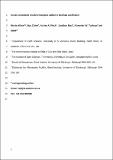Files in this item
Corals concentrate dissolved inorganic carbon to facilitate calcification
Item metadata
| dc.contributor.author | Allison, Nicola | |
| dc.contributor.author | Cohen, I. | |
| dc.contributor.author | Finch, Adrian Anthony | |
| dc.contributor.author | Erez, J. | |
| dc.contributor.author | Tudhope, A.W. | |
| dc.contributor.author | Edinburgh Ion Microprobe Facility | |
| dc.date.accessioned | 2015-09-10T09:40:02Z | |
| dc.date.available | 2015-09-10T09:40:02Z | |
| dc.date.issued | 2014-12-22 | |
| dc.identifier.citation | Allison , N , Cohen , I , Finch , A A , Erez , J , Tudhope , A W & Edinburgh Ion Microprobe Facility 2014 , ' Corals concentrate dissolved inorganic carbon to facilitate calcification ' , Nature Communications , vol. 5 , 5741 , pp. 1-6 . https://doi.org/10.1038/ncomms6741 | en |
| dc.identifier.issn | 2041-1723 | |
| dc.identifier.other | PURE: 173619675 | |
| dc.identifier.other | PURE UUID: 71a285d5-cd22-4797-9288-9709bab6c3a6 | |
| dc.identifier.other | Scopus: 84923300937 | |
| dc.identifier.other | ORCID: /0000-0002-3689-1517/work/38002324 | |
| dc.identifier.other | ORCID: /0000-0003-3720-1917/work/42594130 | |
| dc.identifier.other | WOS: 000347180500001 | |
| dc.identifier.uri | https://hdl.handle.net/10023/7436 | |
| dc.description | This work was supported by the UK Natural Environment Research Council (awards NER/A/S/2003/00473 and NE/G015791/1 to N.A. and A.A.F.; NER/GR3/12021 to A.W.T.). Participation of J.E. and I.C. in this study was supported by DFG project Trion and the Israel Science Foundation (grants 870/05 and 551/10). | en |
| dc.description.abstract | The sources of dissolved inorganic carbon (DIC) used to produce scleractinian coral skeletons are not understood. Yet this knowledge is essential for understanding coral biomineralization and assessing the potential impacts of ocean acidification on coral reefs. Here we use skeletal boron geochemistry to reconstruct the DIC chemistry of the fluid used for coral calcification. We show that corals concentrate DIC at the calcification site substantially above seawater values and that bicarbonate contributes a significant amount of the DIC pool used to build the skeleton. Corals actively increase the pH of the calcification fluid, decreasing the proportion of DIC present as CO2 and creating a diffusion gradient favouring the transport of molecular CO2 from the overlying coral tissue into the calcification site. Coupling the increases in calcification fluid pH and [DIC] yields high calcification fluid [CO32-] and induces high aragonite saturation states, favourable to the precipitation of the skeleton. | |
| dc.format.extent | 6 | |
| dc.language.iso | eng | |
| dc.relation.ispartof | Nature Communications | en |
| dc.rights | Copyright 2014 the Authors. This work is made available online in accordance with the publisher’s policies. This is the author created, accepted version manuscript following peer review and may differ slightly from the final published version. The final published version of this work is available at https://dx.doi.org/10.1038/ncomms6741 | en |
| dc.subject | GE Environmental Sciences | en |
| dc.subject | QD Chemistry | en |
| dc.subject | QH301 Biology | en |
| dc.subject | QL Zoology | en |
| dc.subject | BDC | en |
| dc.subject | R2C | en |
| dc.subject | SDG 14 - Life Below Water | en |
| dc.subject.lcc | GE | en |
| dc.subject.lcc | QD | en |
| dc.subject.lcc | QH301 | en |
| dc.subject.lcc | QL | en |
| dc.title | Corals concentrate dissolved inorganic carbon to facilitate calcification | en |
| dc.type | Journal article | en |
| dc.contributor.sponsor | NERC | en |
| dc.contributor.sponsor | NERC | en |
| dc.description.version | Postprint | en |
| dc.contributor.institution | University of St Andrews. School of Earth & Environmental Sciences | en |
| dc.contributor.institution | University of St Andrews. Marine Alliance for Science & Technology Scotland | en |
| dc.contributor.institution | University of St Andrews. Scottish Oceans Institute | en |
| dc.contributor.institution | University of St Andrews. St Andrews Isotope Geochemistry | en |
| dc.contributor.institution | University of St Andrews. Earth and Environmental Sciences | en |
| dc.identifier.doi | https://doi.org/10.1038/ncomms6741 | |
| dc.description.status | Peer reviewed | en |
| dc.identifier.grantnumber | NE/G015791/1 | en |
| dc.identifier.grantnumber | NE/I022973/1 | en |
This item appears in the following Collection(s)
Items in the St Andrews Research Repository are protected by copyright, with all rights reserved, unless otherwise indicated.

